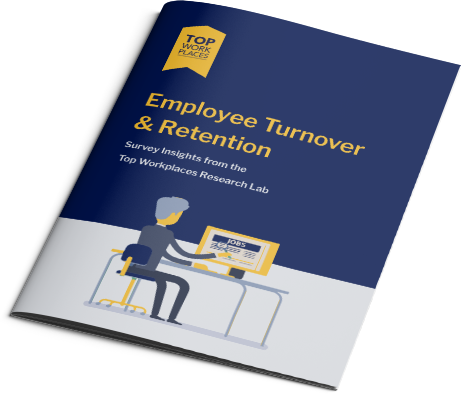
Dive into insights from the Top Workplaces Research Lab by downloading the infographic on Employee Turnover and Retention.
An effective employee retention program is essential for companies looking to attract top talent and reduce unwanted employee turnover. It’s also critical to business performance because retaining your best employees is more efficient than recruiting, onboarding, and developing new talent.
It begins with workplace culture — every company has one. But a culture that keeps employees engaged, motivated, and committed doesn’t happen by chance. It takes intentional effort to create a people-first culture.
Based on more than a decade of workplace research, we compiled a list of 14 successful strategies for improving employee retention. These are strategies you can incorporate starting today.
We also included information about the value of employee retention and its role in developing a culture positioned for growth. So, let’s get started.
Why is employee retention important?
There are many ways employee retention strategies are beneficial to your organization. When employees want to stay with your company, a knowledgeable and experienced workforce is the result. Employee retention also saves your organization a lot of expense.
According to Forbes, the turnover cost of an entry-level job is estimated at 50 percent of the annual salary. That number increases 125 percent for mid-level employees. And for senior executives, the associated expense is as much as 200 percent!
But what’s the most significant reason you should improve employee retention? Retaining engaged employees who are motivated, productive, and willing to recommend your company to their networks.
Best employee retention strategies
The employee retention strategies best suited for your company are based on what matters most to your employees, but here are 14 proven ideas to reduce unwanted turnover and boost employee engagement.
1. Evaluate and address employee pain points
The most effective and productive way to uncover why employees want to leave is to ask them directly. Seek feedback through one-on-one conversations, team meetings, or employee engagement surveys.
Once you have captured that feedback, it’s up to you to listen and take action. In addition to gaining valuable insights, employee engagement surveys can strengthen the connection with employees who feel valued and heard.
2. Offer competitive pay and benefits
It’s no secret that competitive salaries are an attractive way to retain employees. When your workforce doesn’t have to worry about financial stability, they’re motivated to do their job and do it right.
Great benefits are equally important. They keep your workforce mentally and physically healthy. Strong benefits also help to prevent employee burnout. If you’re looking for employee retention strategies that have an immediate impact, competitive wages and benefits can be effective.
Tips for improving pay and benefits:
- Understand the market
- Benchmark your salaries
- Offer a variety of optional benefits
- Encourage feedback about pay and benefits
3. Prioritize improving employee engagement
To increase employee retention rates, focus on improving employee engagement. The two concepts are related. When employees are engaged at work, they’re far less likely to leave.
Employee engagement starts with leadership that believes in and prioritizes a people-first culture — and that begins with knowing what matters most to your employees, listening to their feedback, and taking action on that input. It’s how you create a connection that makes employees feel valued and appreciated. In return, they will bring their best to work every day.
If you have remote workers, maintaining engagement requires some unique approaches. Here are some remote employee engagement strategies that work.
4. Emphasize effective leadership and managing for retention
Poor management harms employee experience and engagement. When your workforce believes leadership fails to communicate and doesn’t understand what’s really going on, they are less likely to stick around. Putting effort into developing strong leadership and hiring the right managers is one of the most effective employee retention strategies.
5. Focus on building a people-first culture
If you’re not intentionally building and nurturing a people-first culture, you’re left with a culture that will form independently. Accidental cultures are often toxic, leaving employees feeling unsafe, uncomfortable, and undervalued. They’re also a primary reason employees choose to go.
The solution for improving company culture is to prioritize and pay attention to it every day. Employ strategies that enhance relationships throughout your organization, promote connection and inclusivity, and encourage two-way communication.
6. Improve employee work-life balance and prevent burnout
Employees look for great workplaces that respect their personal lives and prevent employee burnout. If your organization is looking for innovative employee retention strategies, pay attention to workplace flexibility and work-life balance. Done right, employees will be more productive, energized, and engaged.
To get started, here are five tips:
- Consider the ways your company is willing to support workplace flexibility.
- Recognize employees based on what they do, not the hours they work.
- Experiment with various hybrid work models to find one that suits your company culture.
- To reinforce work-life flexibility in your culture, it is essential that those at the top lead by example.
- Implement strategies to prevent employee burnout.
Learn more: Ways to Deal With Burnout in the Workplace
7. Offer professional development and advancement opportunities
Your employees want to know that they’re working toward something bigger and better than where they started. They’ll look elsewhere when they sense there’s little room for growth.
Some things to consider:
- Employees own their development, but they need manager support to succeed.
- Help managers keep an eye out for cross-training or development opportunities with interdepartmental manager meetings.
- Make sure new job opportunities are publicized within the organization.
- Ensure managers are incentivized for the growth of their employees, even if it results in transitions across teams.
- Consider ways to improve training and development strategies.
8. Recognize employees through positive feedback and awards
Who — and what — you celebrate tells employees a lot about the type of culture you have and the culture you want. Appreciation is a key driver of employee engagement. It’s also one of the simplest, least expensive ways to show employees they are valued.
Quick tips for incorporating employee recognition and appreciation into your culture include:
- Take every opportunity to offer a sincere compliment or a simple “thank you.”
- Think about the ways people prefer to be appreciated. If you don’t know, ask.
- Encourage and role model a culture of peer-to-peer appreciation.
9. Encourage creativity in the workplace
Employees sometimes leave because of simple boredom. The same old work day in and day out can trigger some to search for new employment and maybe even a new career.
To prevent unwanted employee turnover, incorporate ways to encourage creativity in the workplace. Creativity makes work fun. It also encourages innovation, which is essential to growth and success.
Ideas for encouraging creativity:
- Build a diverse team of people.
- Start the workweek with an icebreaker or team-building activity.
- Don’t be afraid to break the rules.
- Use brainstorming activities to spark out-of-the-box thinking.
10. Hire the right employees and onboard effectively
Sometimes, the most talented and qualified candidate is not the best fit for the job. Hiring the right employees is the difference between a revolving door and a team that sticks around. Consider these ideas to improve your employee recruitment process.
But don’t stop there. The right hire can be wasted by a poor onboarding process. Make sure that the experience of joining your organization is an exceptional one.
11. Build an employer brand employees can be proud of
Employees want to work for a company that aligns with their personal beliefs. A strong employer brand and clear company values serve as a strong foundation that holds your company together, especially during challenging times.
Becoming an organization that makes employees proud gives them a reason to stay. Consider these ideas to boost your morale and build your employer brand:
- Earn credible employer recognition as a people-first culture.
- Showcase what makes your organization special and unique.
- Encourage commitment across the diversity spectrum by promoting diversity, equity, and inclusion.
12. Avoid significant and sudden changes
It’s natural for people to resist change — in their everyday lives and at work too. Jarring shifts can leave employees feeling anxious and unbalanced. Frequent changes can also cause them to pack up and leave.
While change is inevitable, avoiding big, abrupt changes is in your company’s best interests. Being transparent and communicative about what’s happening sets expectations and helps employees to feel more secure.
13. Offer workplace flexibility
One of today’s most essential employee retention strategies is workplace flexibility. Job seekers look for employers with flexible environments where they can work where and when they please. That level of independence supports employee well-being and confidence, ultimately making flexible workplaces more enjoyable.
If a fully remote environment sounds like too much independence, don’t worry. There are six different types of hybrid work models, ranging from fully remote to fully in-person.
14. Encourage collaboration
Encouraging collaboration and team building is a great way to improve employee engagement levels. Collaborative teams are often more engaged and productive because they can rely on each other for support and motivation.
That connection fosters new ideas and decreases the risk of burnout or disengagement. Just imagine how productive an organization can be when that collaboration crosses team lines and goes interdepartmental.
How to implement an employee retention strategy
With several employee retention strategies to consider, it’s time to choose those best suited for your company and then take action. How you implement your plan is just as important as choosing the steps to take.
Here’s a basic four-step outline for implementing your employee retention strategies:
- Review your company’s turnover rates to assess your needs.
- Base your employee retention strategies on those needs.
- Establish a plan of action for implementing strategies.
- Execute and evaluate your results.
Start developing your employee retention strategy
The first step in developing an employee retention strategy is to understand and address employee pain points within your organization. These insights can help to inform your actions going forward. Start by capturing honest and anonymous feedback from your employees who know your organization best.
Top Workplaces is based solely on the results of an employee engagement survey. In addition to measuring your company’s current turnover threat, you’ll also qualify for credible employer recognition.
Nominate your organization for Top Workplaces, the recognition program that’s powered entirely by employee feedback.

